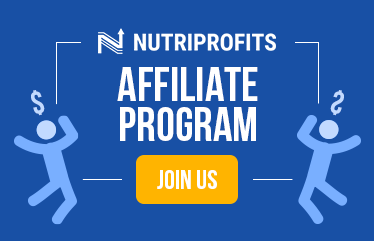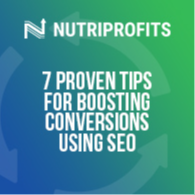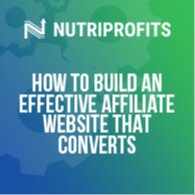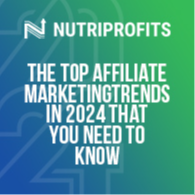Think back to 50 years ago when the best traffic form was the vehicles zooming past a roadside gas-station and an adjacent motel. Nobody bothered counting because conversions into sales were in realtime. The lighted sign 50 yards up the road was all the marketing needed.
Now it's all upgraded. The roadside lodge advertises on a dedicated website with backlinks from all platforms promoting Nevada tourism, Las Vegas Casinos, and area 51 conspiracies. It's a marketing advancement, but it's a rat race in cyberspace.
There are some reliable traffic origins on the market, and you’d do well to enlist your ad campaign. The thing is, it becomes a bit more sophisticated because of monetization. As I’m sure you've realized, other domains' cooperation in promoting a site is invaluable to a business.
In this article, we scrutinize sources and turn the spotlight onto affiliate marketing as we embark on our search for the best traffic generators for this purpose.
What Is a Traffic Source?
Traffic sources differ according to whether you’re a webmaster or media buyer.
For webmasters, audiences generally tend to frequent many platforms through which they find their products. It turns out that each visit and session on a webpage is traceable. The latter honks of privacy invasion and is taboo, but still a valuable market research tool.
For media buyers, it’s different. There are sites where you can purchase traffic. The operator exposes your link or banner in a network, and, in so doing, it gives your site exposure.
A low click-to-conversion ratio speaks of prime sources. If there’s a considerable difference between the number of clicks on a link and sales generated from the same, it means there are discrepancies.
While the above-mentioned ordinarily points to a lower-quality outcome, in many cases, it’s the result of ‘click farms’ which churn out bot-generated visits to web pages. The latter is known as clicker fraud and is why the Recaptcha safeguard is popularly employed.
We look at some of the most useful sources below.
Mainstream Traffic
For the most part, the mainstream source includes origins like social media. It’s a PG-13 or family-friendly platform. It’s likely to bring in traffic from a diverse demographic.
Verticals covered by mainstream sources are:
- Mobile Content
- Gambling
- Nutraceuticals
- Dating
- Travel
- eCommerce
- Finance
- Mainstream VOD
The Targeting Options that are Available
Advertisers can also target specific demographics through various means and methods. Below are just some of the targeting styles used by advertisers.
- GEO targeting allows you to focus on specific geographical locations; these are predominantly countries or regions.
- Certain age groups prevalent on specific platforms have become easy to target.
- Gender information issubmitted wittingly in sign-up procedures on the net or with application-based memberships. The AI employed in both cases assists by using accumulated data for smart and targeted marketing.
- Time of day plays a significant role. Those who have active jobs and are away from their phones interact on social media at specific times of the day only. Civil servants, drivers, builders, restaurant staff, and many more make up most of the workforce. The best time to target the said demographic is after-hours.
- Operating Systems (iOS vs. Android) broadcast to a large audience and are handy tools for the appropriate verticals.
- Web browsers are the standard targeted elements of online marketing.
- Devices like smartphones are potent mechanisms. Because they grant access to the net from anywhere, they tend to spend a lot more time connected to the internet than the average desktop. Thus, any campaign orientated towards smart devices gets a lot more exposure than the desktop browser.
- Websites with many backlinks generate traffic from a large audience.
- Specific languages are easily deployable for access to a particular nationality or region.
Four primary sources for affiliate traffic are context and search, mobile, social media, and Pay-Per-View. We take a closer look at major players in these categories.
Context and Search
The content search advertising tool is useful in generating quality leads. It’ll only trigger the ad if it’s connected to the topic, and in so doing, it displays to a more relevant audience. Thus, the conversion-to-click ratio becomes smaller.
Google Ads
Google Ads is offered by the most popular search engine throughout the world and thus creates a useful traffic source.
The Pros:
- It comes with its key selection tools.
- It has a varied range of settings.
- It offers a wide variety of advertising formats.
- The cost per click is relatively low.
- Google Ads hasn’t got a minimum budget.
The Cons:
- It requires in-depth semantic core development.
Yahoo
Yahoo is a platform that combines search, contextual, and mobile advertising.
Pros:
- It boasts a wide array of settings.
- The cost per click is economical.
- A minimum budget of $5 is needed.
- A campaign developed on Google ads can be downloaded and applied to Yahoo.
The cons:
- Like Google ads, it requires an extensive semantic core.
Baidu
This search engine dominates in China. It doesn’t advertise adult entertainment, tobacco, or gambling.
The Pros:
- Companies use ‘brand zone’ to capture traffic through search results.
- It has a simplified payment system using digital wallets and cards.
- Baidu as a source is lucrative as it has massive coverage across Asia.
Cons:
- The platform requires a deposit of 5600 yuan, which is non-refundable.
- Registration is a lengthy process that entails four stages.
Bing Ads
Bing is especially popular in Canada, France, the USA, and England. It accounts for most of the percentage of users not reached by Google.
The Pros:
- It has a tool for essential selection.
- It has wide array settings.
- Bing possesses the ability to import campaigns from Google AdWords.
- The ads’ time automatically adjusts to the zone of the selected country.
- Cost of traffic is cheaper than Google Ads.
The Cons:
- A limited number of languages(12) and countries(34) available for targeting.
Mobile Traffic
There are approximately 3 billion smartphone users worldwide, making mobile interfaces an excellent source. They are fair game as an audience. These ads come with a call-to-action button and a bit of visual imagery attached.
Rich Ads
Rich Ads is a self-performance platform. This means that it allows the advertisers full access and control to the campaign at all times. In doing so, the pop-up ads can go up at optimal times to capitalize on traffic.
Pros:
- A hands-on performance team and personal ad experts are at the disposal of the advertiser.
- Rich Ads (also known as Push Ads) has over 4 billion ad impressions daily and operates in 200+ countries.
- It employs proprietary technology like Micro Bidding, Automated Rules, Target CPA, and Smart CPC.
Cons:
- It only has PayPal as a payment option.
Airpush
The outstanding feature of the platform is its ability to convert any vertical. It’s a competitive entity on the market and is adept at handling large volumes of high-quality traffic. Airpush is one of the best in terms of advertising management.
Pros:
- It possesses a variety of ad formats.
- It has a great support structure.
- Airpush requires a minimum budget of $50.
Cons:
- The platform has way too many settings, which can become confusing after a while.
- Countless details need sorting through, but their support team help with the process.
Startapp
This source orientates to in-app smart device advertising and hence makes a great source of mobile traffic. It possesses tech-rich advert formats like; 360 degrees,cross-page, interactive ads, virtual reality, and native videos.
Pros:
- It has worldwide coverage ( more than a billion devices ).
- Startapp requires a minimum budget of $50.
- A variety of formats is available.
- The platform possesses comprehensive analytics.
Cons:
- It only has Paypal as a payment option.
Go2mobi
Banners, multimedia, video ads, and mobile advertising are available from this service. Go2mobi tends to be cheaper than real-time bidding.
Pros:
- Allows for optimization through flexible settings.
- It offers personal account management.
Cons:
- We recommend taking the training course in the inventory section before attempting to navigate and use the service.
Social Media Traffic
In most cases, this source gathers a diverse crowd of people from different cultural backgrounds across various GEO locations. These platforms are thriving marketing hubs connecting many to a single site in cyberspace. In its other forms, social media is a useful tool adept at converting audiences into profit.
Facebook is the most significant paid traffic source. It’s user friendly and gets you exposure in a record amount of time. There’s an analytics system in place that is comprehensive, rendering detailed metrics.
Pros:
- fferent advertising formats:
- Video ads
- Photo ads
- Slideshow ads
- Carousel ads
- Canvas ads
- Dynamic Product Ads
- Options are available for ad placement.
- Beginners get assistance from Ads Managers.
- There is a minimum credit requirement of five dollars.
Cons:
- Content posted by advertisers experiences heavy moderation.
- Banning can occur quickly.
Instagram links to Facebook, directing all targeted advertising. The platform’s unique feature is that you don’t need to have an account before you start marketing.
Pros:
- The app launches quickly, making it easily accessible.
- It provides flexibility in its settings.
- The social media entity allows for complete control over statistics.
- It has a profound ability to reach ‘look-alike’ audiences.
Cons:
- It doesn’t have a standardized video setup.
- An ad on Instagram would need setting-up via Facebook.
Twitter is a microblogging service. A fair amount of people from diverse social and professional standings hold memberships and frequent the platform.
Pros:
- The site has a high click-through rate and a high level of user interactions.
- Low-level competition occurs on the site.
- Advertising is low cost.
Cons:
- It has a character limit (140).
- While Twitter allows you to link a video from another platform, it doesn’t permit desktop uploads.
Youtube
Because video advertising is so impactful, Youtube is one of the most effective social media platforms for generating leads. It's possible to use text, videos, and banner advertising on this platform. It’s available in over 70 countries and airs in more than 60 different languages.
Pros:
- Six ad formats available types of advertising messages:
- Display Ads
- Overlay Ads
- Skippable Video ads
- Non-skippable video ads
- Bumper ads
- Sponsored cards
- Low levels of competition exist on Youtube even though it's a well-known source.
- Low price costs for advertising, its broad scale of exposure, and large numbers of customers generate quick revenue.
- It offers high-quality traffic in that the searches are specific, allowing ads to go where they’re relevant.
Cons:
- Google Adwords account is needed.
- There are special requirements for promoted offers.
PPV Traffic (Pay-Per-View)
This is a rather intrusive form of getting attention and is usually considered malicious.
A window opens under the browser as you navigate your way onto a specific page. The upside for the audience is that these deals usually come with free online tools, like an SEO implement or a plagiarism checker.
The cost is the constant advertising appearing on the page. It’s a mechanism generating high-quality at the expense of the viewer experience.
Propelmedia
A noticeable feature is a prime grade of traffic. It uses text strictly and makes accommodations for translation into other languages by using cross-border ads.
Pros:
- It’s easy to use through a simple interface.
- It’s known to generate high-quality traffic.
- Propelmedia boasts responsive support and personal account management.
- Includes an embedded algorithm designed for audience selection.
- Reports metrics on multiple levels.
Cons:
- A high minimum budget is required - $1000.
- The advertiser needs to open up a separate account for each country.
Playwire Media
The first thing you should know about this platform is that it's highly professional and is known for its creativity and optimum placements. Playwire is adaptable to any device and thus enjoys a magnificent amount of exposure.
Pros:
- It’s agnostic, meaning; it’s adaptable to any operating system.
- The brand keeps its reputation exclusive to reliable sites only.
- Playwire Media has its analytics and optimization mechanisms in place.
- The online firm also provides free training on how to increase conversion rates.
Cons:
- There are no real cons apparent.
Mediatraffic
Mediatraffic’s defining feature is that it provides context-conscious advertising. Traffic borne of their site is high-quality as the clicks generated have a large degree of real interest.
Additionally, they offer full transparency to the advertiser, but also confidentiality and control.
Pros:
- It’s a valuable source, with over 15 million users from different backgrounds.
- The platform has a high potential for profitability.
- Media traffic also provides personal campaign management.
Cons:
- The brand has a relatively steep minimum budget of $200.
Rapsio
Another high-quality traffic source. This platform focuses on text and cross-border ads.
Pros:
- Rapsio is user friendly with a simple interface.
- As mentioned before is its ability to function as a reputable source.
- As a platform, it has responsive support and a personal manager.
- It possesses an algorithm for audience selection.
- The platform has multi-level reporting.
Cons:
- Registration only occurs by application, and there is a waiting period before you get a response.
- Rapsio requires a minimum budget of $1000.00.
Additional Options Used for Exposure and the Creation of Web Traffic
Url Shortening Tools
A URL Shortening Tool’s function is to do away with the excess text that makes a link lengthy. Another more powerful feature of the mechanism is its capacity to trace traffic origin. The shortened links are usable in documents, posts, and articles anywhere on the web.
Here are a few examples.
- Bitly is for agnostic use.
- Rebrandly helps create branded links.
- Polr makes a lite version self-hosted URL shortener.
- TinyURL creates quick, anonymous short URLs.
- BL.INK works best for small businesses.
- Hyperlink traces links through push notifications.
- T2M creates QR codes and short URLs.
- URL Shortener by Zapier automatically builds links.
- Yourls for a flexible self-hosted URL shortener.
- Shorby’s design is with Instagram users in mind.
Native Advertising
In online advertising, there is a thing called ‘banner blindness.’ The latter is a case where the audience becomes so accustomed to the repetitive appearances of ads on webpages that they ignore them.
The answer comes in the form of what’s called a native ad. These advertisements are molded into the design of the webpage in a manner, making it look natural. It takes on the site’s font and theme, and thus the user becomes a lot more comfortable with clicking on ads.
Media Buying
Simply put, media buying is the wholesale purchase of advertising space and airtime; this is directed not only through the internet but also from sources like magazines, radio, and TV commercials.
Retargeting
Retargeting, as a source, has great potential for conversions. It’s a concept of showing ads to a user on the next web page after leaving a site relevant to the ad. As tricky as it may sound, it’s proven effective.
Affiliate Marketing Aspects for Consideration
Target Audience
To arrest a specific demographic’s attention, a lot of effort and research has to go into understanding them. Is your niche market middle-class or an upper-income bracket? Are they in their teens, are they breadwinners, are they decision-makers in corporate settings, or are they college students? Your target audience will determine what your traffic source will be.
Quality Offered by the Traffic Source
The marketer has to be mindful of the audience for another reason: Do they ( the potential customer) frequent the platform you’ve chosen? Does the site appeal to the sort of clientele whose interest is piqued by your ads?
If you’ve picked social media as a source and you’re selling bathing suits, would Instagram or LinkedIn be better suited for the purpose?
Regulations and Restrictions
The rules and regulations on a source can be restrictive and not clear on their boundaries. The restrictions may be age or morally defined; this could mean no adult or gambling material is permissible.
The Cost of the Traffic Source
Each source has a specific type of traffic, which gets directed into a particular area targeting. The caliber of it usually influences the costs associated.
The Quantity of Traffic Rendered by the Traffic Source
It’s a significant factor in choosing a source. Low traffic means fewer visits. Ideally, you want large numbers of quality clicks. Bear in mind that quantity never compensates for quality with affiliate marketing.
Wrapping it Up
The online market mechanisms at our disposal are always in a state of evolution. All the aspects of online advertising are hardly ever encompassed in a single campaign, and frankly, it’s unnecessary if not impossible.
The most valuable commodity on the internet today is traffic. Like any other useful resource, there are various qualities, and it gets manipulated through the aqueducts of the internet as if it were water.
-1-1.jpg)




.jpg)

-1-1.jpg)